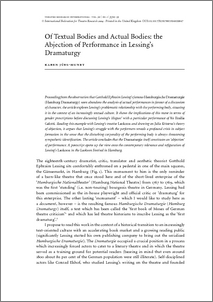Of Textual Bodies and Actual Bodies: the Abjection of Performance in Lessing's Dramaturgy.
Jürs-Munby, Karen
(2005)
Of Textual Bodies and Actual Bodies: the Abjection of Performance in Lessing's Dramaturgy.
Theatre Research International, 30 (1).
pp. 19-35.
ISSN 1474-0672
![[thumbnail of jm1.pdf]](https://eprints.lancs.ac.uk/4229/1.hassmallThumbnailVersion/jm1.pdf)

Preview
Abstract
Proceeding from the observation that Gotthold Ephraim Lessing's famous Hamburgische Dramaturgie (Hamburg Dramaturgy) soon abandons the analysis of actual performances in favour of a discussion of character, the article explores Lessing's problematic relationship with the performing body, situating it in the context of an increasingly textual culture. It shows the implications of this move in terms of gender prescriptions before discussing Lessing's ‘disgust’ with a particular performance of his Emilia Galotti. Reading this example with Lessing's treatise Laokoon and drawing on Julia Kristeva's theory of abjection, it argues that Lessing's struggle with the performers reveals a profound crisis in subject formation in the sense that the disturbing corporality of the performing body is always threatening sympathetic identification. The article concludes that the Dramaturgie itself constitutes an ‘abjection’ of performance. A postscript opens up the view onto the contemporary relevance and refiguration of Lessing's Laokoon in the Laokoon Festival in Hamburg.
Item Type:
Journal Article
Journal or Publication Title:
Theatre Research International
Additional Information:
The final, definitive version of this article has been published in the Journal, Theatre Research International, 30 (1), pp 19-35 2005, © 2005 Cambridge University Press. This article is a cornerstone of J'rs-Munby's ongoing inquiry into the history of acting in relation to historical media shifts. An earlier version of it was presented at Performance Studies International in Mainz (2001). The article repositions the prevalent understanding of G.E. Lessing's canonical Hamburgische Dramaturgie (Hamburg Dramaturgy, 1767-1769) by situating it in the context of a historical media shift towards an increasingly textual culture in the latter half of the eighteenth century. Proceeding from the often-overlooked fact that Lessing soon abandons the analysis of actual performances in favour of a discussion of character, the article explores Lessing's problematic relationship with the performing body and shows the implications of this move in terms of gender prescriptions. It is the first study to theorize Lessing's 'disgust' with particular performances by reading it with his seminal treatise Laokoon: or the Limits of Painting (which discusses the changing effects of representation in different artistic media) and by drawing on Kristeva's and Lacan's psychoanalytical theories of subject formation and abjection. A postscript draws connections with the international Laokoon Theatre Festival in Hamburg and opens up the view onto the contemporary 'postdramatic' relevance of Lessing's media-theoretical Laokoon in an age when the performing body is newly valorized. RAE_import_type : Journal article RAE_uoa_type : LICA
Uncontrolled Keywords:
/dk/atira/pure/subjectarea/asjc/1200/1213
Subjects:
?? visual arts and performing artsliterature and literary theorynx arts in general ??
Deposited On:
29 Feb 2008 14:05
Last Modified:
19 Sep 2025 03:19